The Gothic Archway
The Gothic archway dates from the 13th century and was built with stones in a monastery format. It runs in a pointed arch with a stepped robe. There is no explanation as to why the single archway was preserved and to which courtyard it led. One explanation: it could have been the entrance to the headquarters of the Kaland Brotherhood, which was dissolved with the Reformation in 1560.
Source: A. Perlt rectory Wusterhausen/Dosse
From the Reformation until 1967, the city of Wusterhausen was the center of a church district. The superintendency (upper parish) was located here as the administrative headquarters. There was the head pastor, who as superintendent led the church district, and the archdeacon, who as the second pastor stood by the first. That is why there were two vicarages, both of which are next to each other. Between the two buildings is a Gothic archway, the remains of a medieval monastic complex. In addition to the vicarages, the parish also owns the "Kaland" community center on Am Burgwall Street, built in 1907. The name is reminiscent of the medieval Kalnd Brotherhood.
The parish districts include the parishes of Gartow (since 1541), Bantikow (since 1967) and Brunn, Tramnitz and Schönberg (since 1976).
Rectory I (upper parish), St.-Petri-Straße 5
The following can be read about this building in the "Dehio" from 2000: "Elongated two-story half-timbered building, late 17th century, the threshold zone profiled with visible beam heads." The listed house is therefore one of the oldest residential buildings in the city. For maintenance, this means special care in observing the relevant requirements. Generations of residents have left their mark because it has always been necessary to renovate, repair, modernize and remodel in and around the house - depending on need and necessity. A blatant example of architectural blunders is the replacement of the half-timbered rear facade as a solid wall.
The history of the house and its residents is varied and interesting. Writing about all of the officers living here is beyond the scope of this post. Therefore only a few highlights. Johann Möllendorf served as pastor from 1531. Ten years later, the Reformation was introduced in Wusterhausen. Möllendorf remained in office and was the first evangelical pastor until his death in 1552. Altogether there are 24 up to the current pastorate holder. If the age of the "Dehio" is correct, the current vicarage was built during the tenure of the 9th senior pastor Daniel Rhau (1693-1717), after the town on the 8.4.1679 partly burnt down again. The spacious house served as a residence for the head pastor. The head pastor naturally needed a "study room" and, as superintendent, also rooms for meetings and conventions. When the 18th head pastor, Superintendent Paul Fleischmann, retired in 1933, the position of head pastor remained vacant until 1946. The vicarage served a variety of purposes. At times, the mayor had confiscated rooms. From 1945 the house was occupied by refugee families. As a result, it was in a completely dilapidated state and had to be thoroughly renovated in 1954, when Superintendent Karl Selke moved in again, and a water pipe was added. Only when the last refugee family had moved out in 1956 could service and meeting rooms be set up again. Even after the dissolution of the church district in 1967, the upper parish remained in use as rectory I, not only by the pastor, but also by the cantor and catechist. The last pastor who lived in vicarage I (and had the back font built) was Horst Krahmer from 1966 to 1972. Since then, living space in the house has been rented out, but service and meeting rooms have also remained in use. The vicarage also offered asylum to the museum until 2011, when the building at Am Markt 3 was restored.
The coffee shop is open every Tuesday morning.
Rectory II (archideaconate), St.-Petri-Straße 7
The second pastorate existed from 1541 to 1999 and has not been filled since. The parsonage II was the official residence of the second pastor (“Archideacon”). Like vicarage I, it was built at the end of the 17th/beginning of the 18th century. Although it is also a listed building, repairs and conversions have often been carried out on it over the course of time, the most extensive in 2003/04, when it became the official residence of the incumbent pastor. This comprehensive refurbishment of the half-timbering and the interior was carried out with the support of the urban development program of the state of Brandenburg. In addition to the living quarters, the house contains the pastor's office, the pastor's office and the archive room.
Gothic archway St.-Petri-Straße 5 - 7
In the middle between the two presbyteries there is a Gothic archway from the 14th century, the origin of which has not yet been clarified. In the large vicarage there were historic stables that were destroyed by fire in 2001 and only partially rebuilt.
A mysterious archway - was this where Kaland's house stood? (Text: Dirk Schumann)
Opposite the church, next to the vicarage of the evangelical parish at St. Petri Straße 7, a Gothic archway made entirely of brick has been preserved.
This archway with three tiers (without molded bricks) was also originally intended for a double-leaf door. Its construction with armor holes and the use of a characteristic wall bond reveals its medieval origins. The time when the arch was erected can be further narrowed down based on various construction details. The gradation of the walls, the course of the arches, the creases in the bricks and the wall bond (as far as it is still medieval) with a sequence of two runners on a truss suggest that it was made in the 14th or early 15th century.
This structure is similar to various other medieval cemetery portals preserved in the state of Brandenburg. However, this cannot have been the portal to the former cemetery or churchyard, as this was formerly on the other side of the street around the church.
It is not unimportant that the archway to the south has a connection for a wall that was formerly made of brick, while there is no such connection on the other side. The gate obviously belongs to today's property at St. Petri Straße 5.
The half-timbered house there, parts of which date back to the time before the town fire of 1758, was the residence and office building of the head pastor and later superintendent (until 1968).
As a rule, the houses belonging to the church bordered the churchyard, such as the old school, which was apparently in poor condition even before the Reformation and should therefore now be improved.
The dwellings of several clergymen in the Middle Ages can also be found here.
But apparently there was no longer any suitable accommodation for the pastor here after the Reformation. Because when a sovereign commission came to Wusterhausen in 1541 to regulate the church conditions after the Reformation, they identified the house of the previously deceased priest of the Epiphany Altar as the pastor's new home.
As the archway reveals, this is an important and apparently large property. But how it came into the possession of the furnishings of the Three Kings Altar is not known.
Various people assume that the house of Kaland was once located here. However, there are no indications for this.
It is true that the Kaland played an important role in the ecclesiastical life of the city of Wusterhausen, because he was in charge of several side altars in the city parish church. However, the altar of the Three Kings was not included.
The Kaland is a religious fraternity of clergy, but also welcomed lay people. It was dedicated to performing charitable works for the poor and sick and caring for the afterlife of its members, which means holding services and prayers for their eternal life after death. When in the course of the 15th century clergymen found themselves in precarious employment, support was also given to them. Because the funds donated for altar services (benefits) were often just enough for the livelihood of the respective altarists. The financing of a suitable burial was not yet secured.
The name Kalandsbrotherhood probably derives from the Latin word "kalendae", which means the first day of the month. Because the members usually met on the first day of the month for prayers or to discuss common matters.
It was not uncommon for the Kalandsbrotherhoods to purchase houses in the cities for their meetings and joint work. Accordingly, there may have been a house of the Kalandsbrotherhood in Wusterhausen. But when in the course of the Reformation in 1541 the former extensive property and the income of the Wusterhausener Kalandsbruderschaft were collected, there is no house to be found in this list. Shortly before, the brotherhood had sold their entire income to the Wusterhausen council for 1,300 guilders.
But even if the medieval archway had nothing to do with the Wusterhausener Kaland, this building belonged to a once stately and important property, where there are certainly still one or the other secret to be revealed.
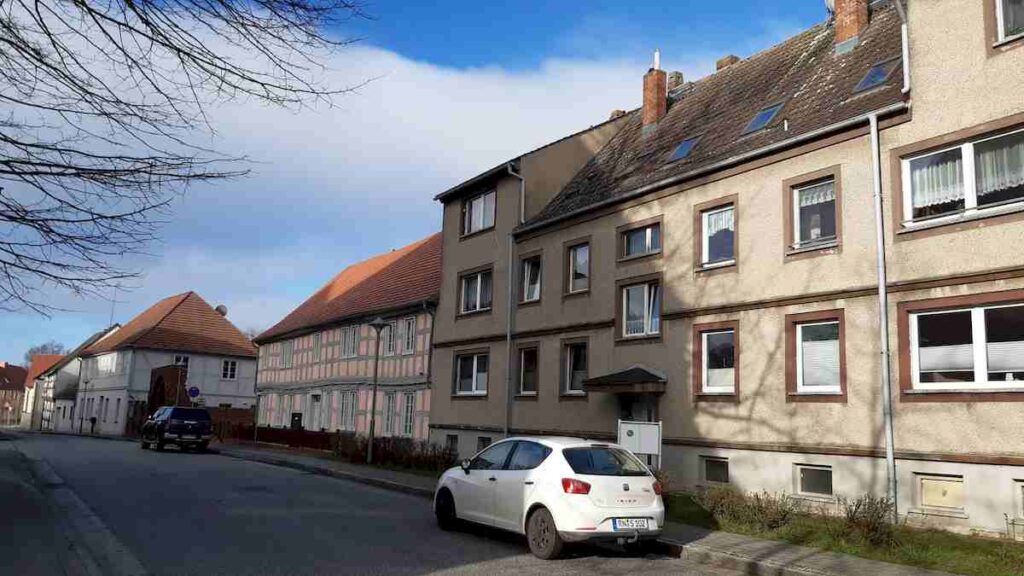
View of the Gothic Gate between the two vicarages
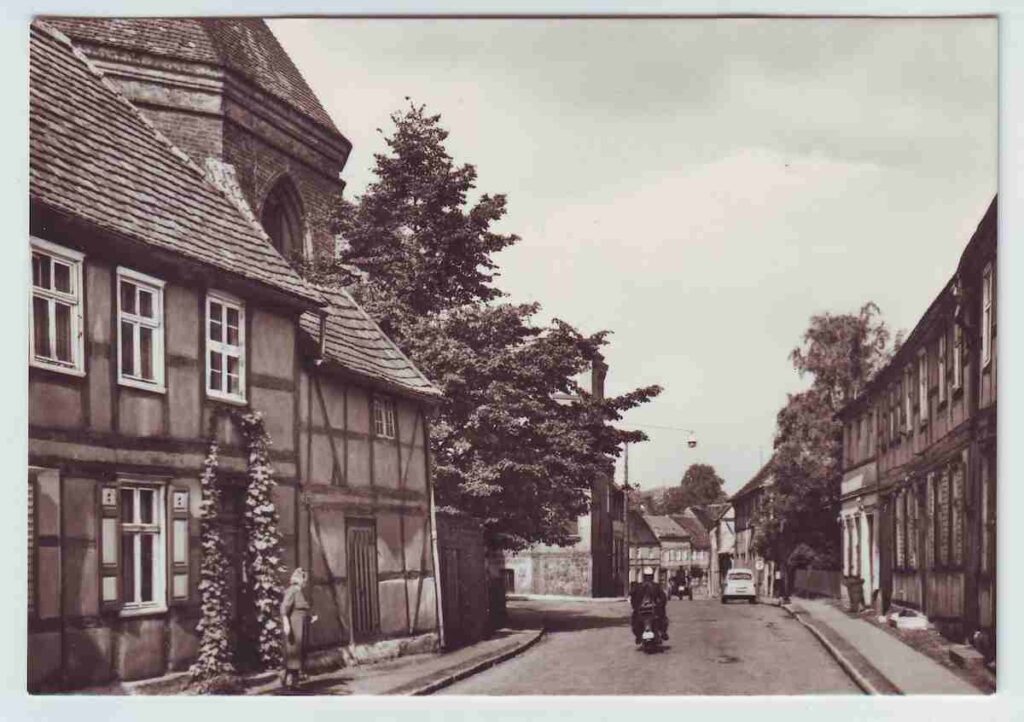
St. Petri-Straße, in the 1960s - the half-timbered houses on the left are no longer there, on the right there is a new building today. Postcard Archive of the Path Museum
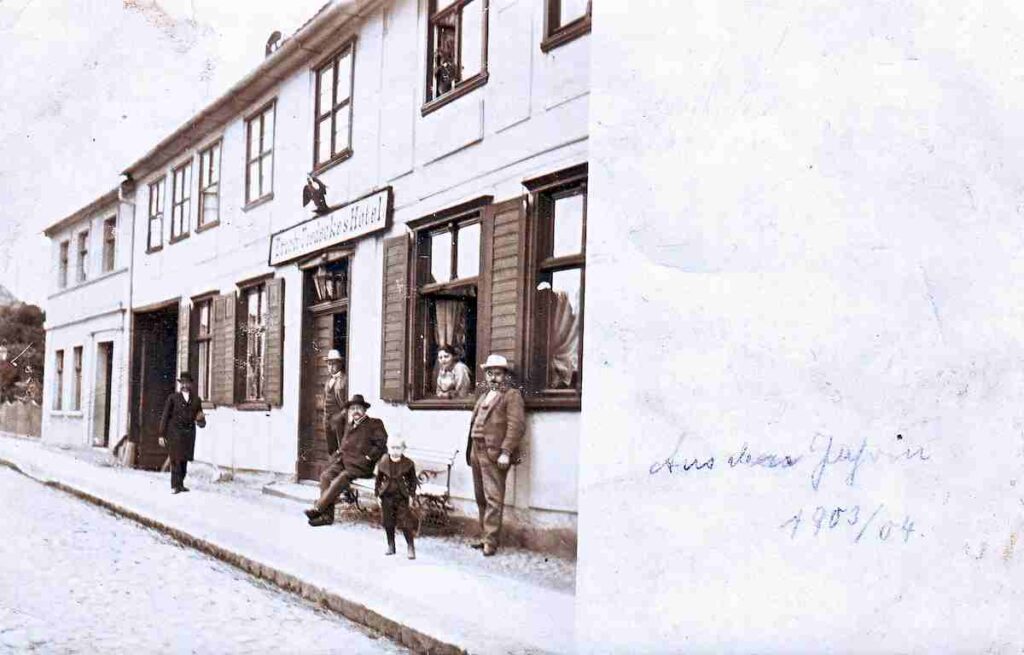
Photo around 1903 - Thielecke Hotel, also Hotel "Zum Schwarzen Adler", the eagle is exhibited in the 19th century room, Wegmuseum
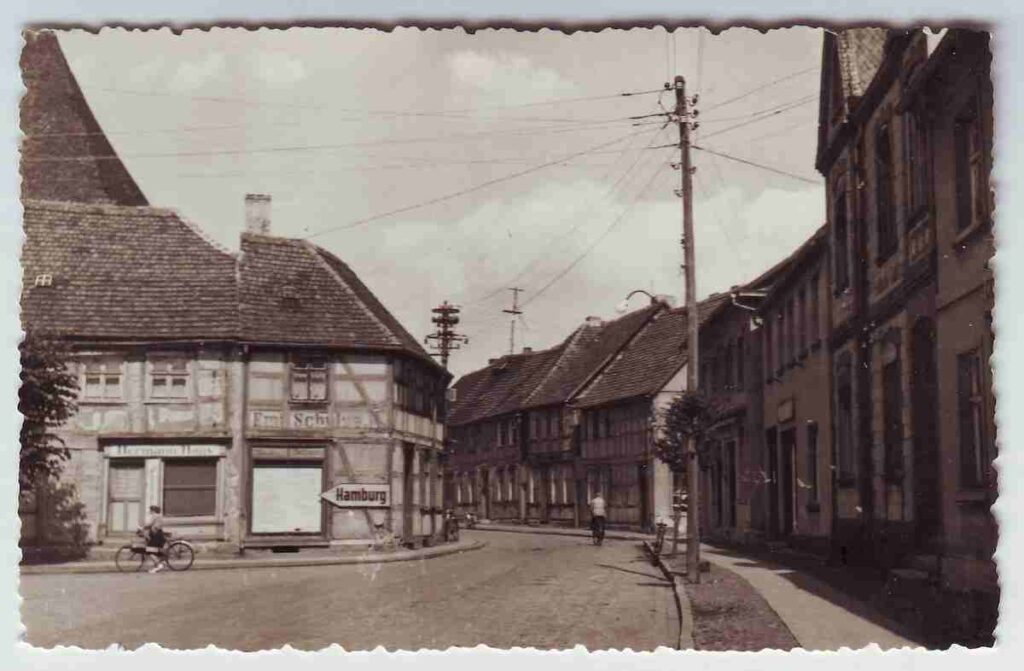
Corner of Markt/St. Petri-Strasse before the bypass was built in the 1960s, postcard from the Wegmuseum archive
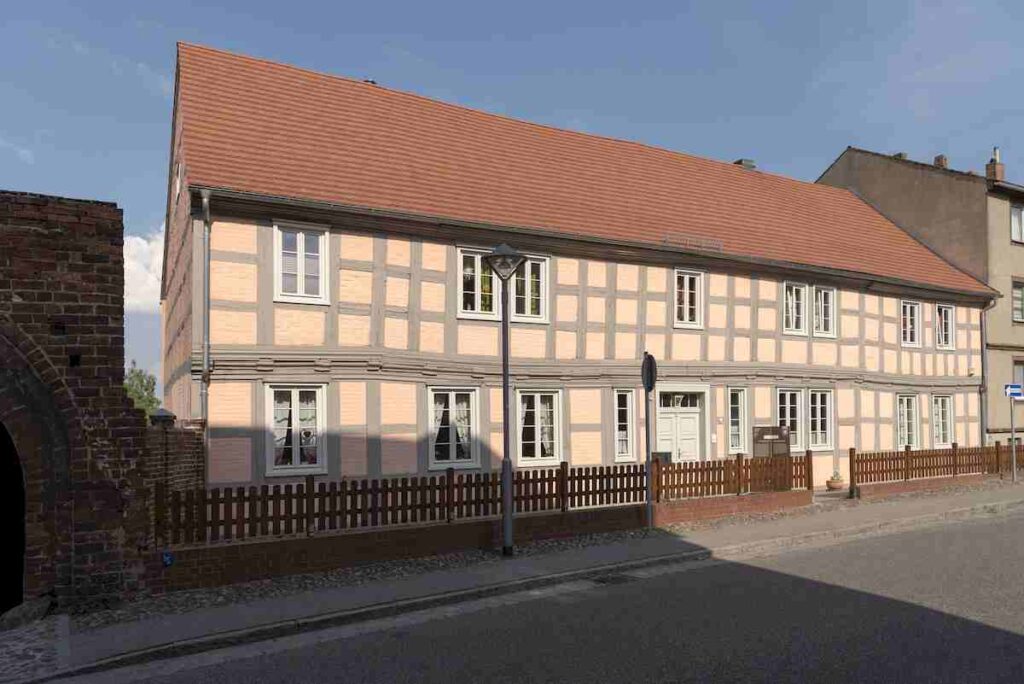
The old Superintendency, now a residential building. The house was extensively renovated in 2004 in line with the preservation order. Photo: Erik-Jan Ouwerkerk
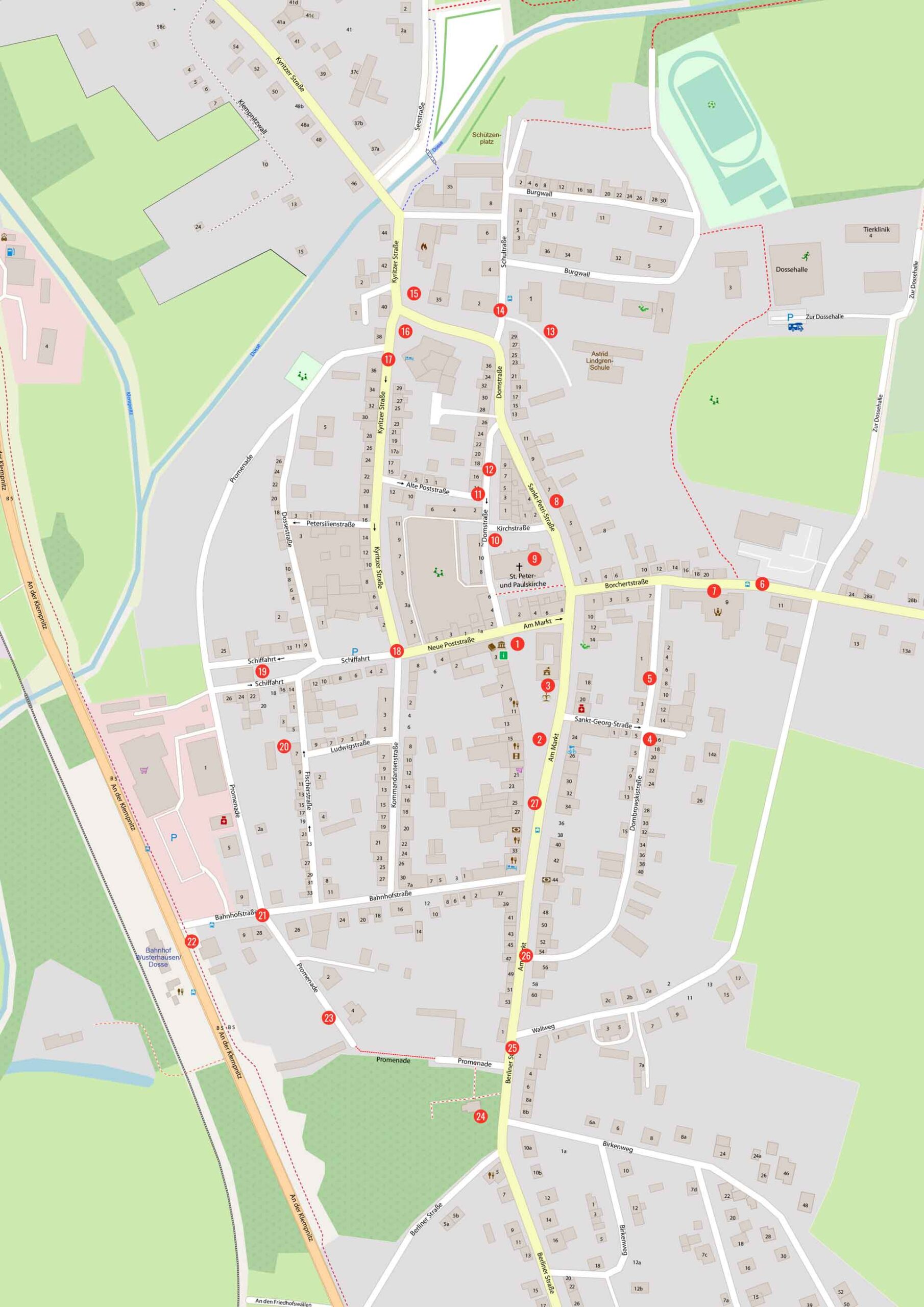
City walk map general view
